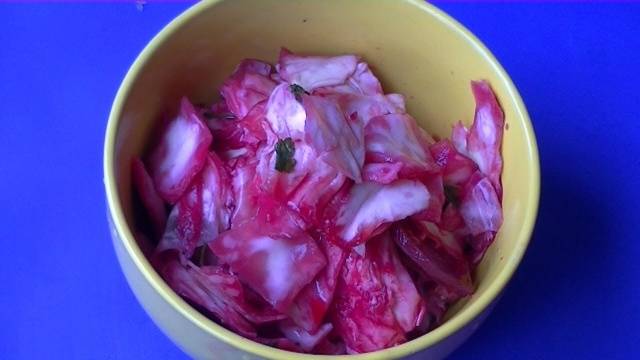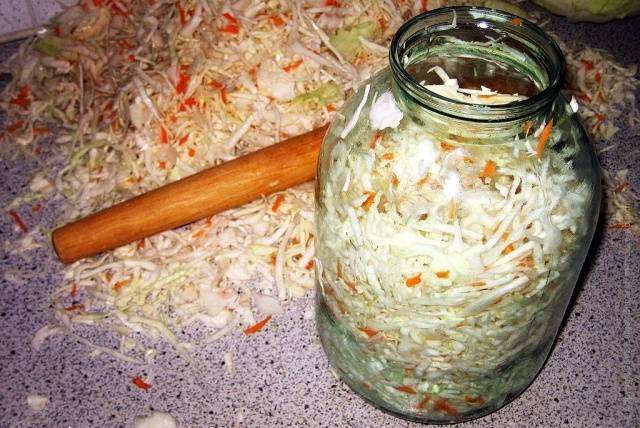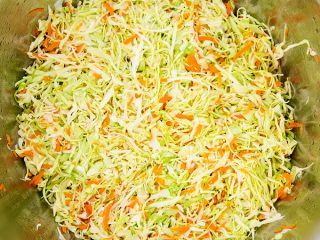Content
Most people love sauerkraut. How nice it is in winter to get a jar of your own homemade preparation. This sour appetizer goes well with fried potatoes, pasta and various side dishes. Our grandmothers fermented cabbage in large wooden barrels, thanks to which it could be stored for quite a long time. Nowadays, it is customary to prepare snacks in small portions so that they do not have time to spoil. How to prepare sauerkraut for the winter? In this article we will look at some tips that will help make the preparation even tastier and healthier. We will also see recipes for winter preparations with photographs and step-by-step instructions.
What are the benefits of sauerkraut?
Each vegetable is healthy in its own way and contains certain vitamins. White cabbage contains vitamin U, which is also called methylmethionine. It helps the body fight stomach ulcers and gastritis. In general, this vegetable is very beneficial for the intestines.
Sauerkraut contains a huge amount of vitamin C. The most interesting thing is that even after six months, its concentration does not decrease. No other vegetables have this ability.Even during heat treatment, vitamin C does not evaporate, but is transformed into ascorbic acid. This is explained by the fact that it is contained in the vegetable in the bound form of ascorbigen.
In addition, the preparation has a positive effect on the immune system and the body as a whole. Cabbage helps fight stress, all kinds of infections and intoxication of the body. It is rich not only in vitamin C, but also contains other trace elements, amino acids and minerals. In addition, it contains a lot of potassium, nicotinic acid and B vitamins. And the fiber it contains helps remove toxins and waste from the body.
Preparing products for harvesting
Lactic acid acts as a preservative in this dish. It forms independently when the lactic acid bacteria that are on the head of cabbage begin to process sugar. During alcoholic fermentation, carbon dioxide and alcohol are produced. But to ensure that the rotting process does not begin, such preservatives are not enough. Therefore, salt is also used during cooking.
You should choose fairly dense, rather than loose, heads of cabbage. White cabbage of late and mid-late varieties is suitable for this. The weight of each head must be 800 grams or more. There may be small defects on the vegetable, but no more than 5% of the entire head of cabbage. It would take a long time to list all the varieties suitable for pickling, but you should focus on those grown in your region. The main thing is that they are late.
Recipe for sauerkraut for the winter
The preparation may consist of different ingredients. But to make it tasty and crispy, you need to follow the basic rules and proportions:
- For pickling we use only late and mid-late varieties of cabbage. Early vegetables have a loose structure of heads and green leaves. Such heads of cabbage contain insufficient amounts of sugar, which impairs the fermentation process.
- Many recipes also include carrots. In such cases, it is necessary to follow exact proportions. The weight of carrots in a salad should be only 3% of the total weight of cabbage. If there is 1 kg of cabbage in the salad, then we take 30 g of carrots.
- Only coarse salt is used for preparation. Iodized one is not suitable for these purposes.
- Salts take from 2 to 2.5% of the total weight of vegetables. It turns out that for 1 kg of cabbage you will need about 20–25 grams.
- To make the preparation more useful, you can use coarse sea salt.
- You can also add various vegetables, fruits and other additives to the salad. Some people throw cranberries, apples, lingonberries, beets, caraway seeds and bay leaves into the preparation. Everyone can determine the amount of these ingredients according to their own taste.
How to ferment cabbage correctly
Sauerkraut - This is a quick and fairly easy process. But if you miss at least one stage, then the preparation may simply not work out. Now let's look at the whole process step by step:
- The first step is to clean the heads of cabbage from the top green or rotten leaves. All frozen or damaged parts are cut off. You should also remove the stalk.
- Next, you need to determine how to ferment the cabbage (whole or shredded). It is not very convenient to ferment whole heads, so most people pre-cut the vegetable.
- Then peel and grate the carrots on a coarse grater. A Korean carrot grater is also suitable.
- Now pour the shredded cabbage onto the table and grind it thoroughly with the addition of salt.All other additives are also added at this stage. You need to grind the salad until it releases juice.
- Next, you need to prepare a container for storing the workpiece. A wooden barrel or enamel pan of the right size is best. The enamel should not be damaged.
- Place cabbage leaves at the bottom of the container. Then the prepared salad is placed there. The workpiece should be laid out in layers of 10 to 15 cm. After each layer, the salad is thoroughly compacted.
- Some housewives who make preparations in large containers like to put them inside a whole head of cabbage. Then you can make wonderful cabbage rolls from such cabbage.
- Then the workpiece is covered with leaves and a clean towel, a wooden circle is placed on the barrel, and on top oppression.
- After 24 hours, the separated brine should appear on the surface.
- For the fermentation process to occur, the container is kept at room temperature.
- During fermentation, bubbles and foam should appear on the surface, which must be collected.
- Next, it is necessary to release gas from the workpiece. If this is not done, then all efforts will be in vain and the cabbage will simply spoil. To do this, every day or every 2 days the cabbage is pierced with a wooden stick to the very bottom in several places.
- When the cabbage has noticeably settled, it is necessary to remove the pressure from it and remove the leaves and the top darkened layer of the cabbage. Then the wooden circle is washed using soda, and the towel is washed in plain water and saline solution. After this, it is squeezed out and covered with cabbage again. Next, place a wooden circle and lighter pressure. The brine should cover the circle.
- If the required amount of brine is not released, it is necessary to increase the size of the load.
- The workpiece is stored in a cool room with a temperature of 0 to 5°C.
- You can determine readiness by color and taste. A properly prepared salad should have a slightly yellowish color, an appetizing smell and a sour taste.
How to make sauerkraut with beets and peppers
To prepare such a preparation we will need:
- cabbage – 1 head;
- beets – 1 large or 2 medium;
- medium-sized carrots – 2 pcs.;
- sweet bell pepper – 3 pcs.;
- dill – 1 bunch;
- garlic – 4 cloves;
- black peppercorns – from 10 to 15 pcs.;
- granulated sugar – 1 tbsp. l.;
- citric acid – 1 tbsp. l.;
- table salt to taste.
The preparation of the salad begins, of course, with cabbage. First of all, it is washed and cleaned of damaged leaves. Then it is cut into 8 or 12 even pieces, as shown in the photo below. Set the cabbage aside and proceed to the beets, peppers and carrots. The peppers are washed, cored and cut into strips. Peel carrots and beets, wash thoroughly under running water and cut in the same way as cabbage. You should get thin plates.
Then all the vegetables are laid out in layers in a prepared container, each layer sprinkled with granulated sugar and salt. Then you need to boil water, pour citric acid into a container with vegetables and pour boiling water over the entire contents. The water should completely cover the vegetables. Then the workpiece is covered with a clean towel and oppression is applied.
Spicy sauerkraut recipe
To prepare sauerkraut according to this recipe, you need to prepare the following ingredients:
- white cabbage – 4 kg;
- beets – 150 g;
- hot red pepper - half a pod;
- garlic – 50 g;
- horseradish (root) – 50 g;
- fresh parsley – 50 g;
- water – 2 l;
- granulated sugar – 100 g;
- table salt – 100 g.
Now let's look at the step-by-step recipe in detail, how to ferment cabbage with horseradish and garlic. Wash the head of cabbage and cut it into large slices. Next, grate the horseradish root. Peel the garlic, wash it and pass it through a press. You can also finely chop the garlic with a knife. Peel the beets and cut into cubes. Wash the parsley under running water and finely chop it with a knife. Hot red peppers must be washed and the core and all seeds removed. It is better to do this with gloves, after which you need to wash your hands thoroughly with soap. All prepared ingredients are mixed.
Next, let's start preparing the brine. To do this, boil 2 liters of water. After boiling, add sugar and salt in the required quantity to the pan. The solution is boiled slightly and cooled. Pour the prepared brine over the vegetable mixture. Then oppression is laid on top and the cabbage is kept in this form for at least 2 days in a warm room. After the fermentation process has subsided a little, the container is moved to a colder place.
How to prepare sauerkraut for the winter
Cabbage can be fermented dry or wet. The dry method is different in that first the vegetable is simply mixed with spices and carrots, and then the mass is compacted very tightly into a prepared container. Between the layers you can also lay out various fruits and vegetables or berries (according to the recipe). Sugar and salt are added to the brine, which needs to be boiled and poured over the compacted vegetables. How to prepare such a brine is described a little higher.
In the second case, you need to grind the shredded cabbage with salt so that the juice begins to release. Then the workpiece is mixed in parts with carrots and put everything in a large container.It is better not to spread the entire mixture at once, otherwise it will be difficult to compact it. If the recipe contains additional vegetables or fruits, then place them in portions between the layers of cabbage.
The workpiece is considered ready, but not completely fermented, when foam stops forming. This salad can be safely eaten. But in order to bring the workpiece to full readiness, you need to keep the container in a cool place for another month. The temperature should not be lower than 0 and not higher than +2°C. The salad can be stored throughout the winter if you follow all the step-by-step instructions.
Conclusion
As we could see, fermenting cabbage for the winter is not at all difficult. This is a quick and enjoyable process that does not require special preparation or large material costs. Everyone can afford to prepare such a tasty and healthy snack for the winter. Moreover, now you know exactly how to properly ferment cabbage at home.



















